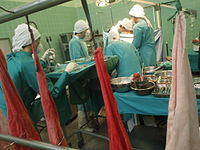
Photo from wikipedia
Objectives: To identify the plasma fibroblast growth factor-23 concentration in children with primary hypertension and the association between FGF-23 and target organ damages. Methods: With retrospective and prospective case-control study,… Click to show full abstract
Objectives: To identify the plasma fibroblast growth factor-23 concentration in children with primary hypertension and the association between FGF-23 and target organ damages. Methods: With retrospective and prospective case-control study, 77children with primary hypertension and 34 healthy children were enrolled with informed consent. According to the condition of target organ damages, children with primary hypertension were divided into target organ damage group (TOD group) and non-target organ damage group (non-TOD group). Basic clinical features were recorded, and target organ damages assessment were completed. Concentration of plasma FGF-23 was detected in all children by ELISA test. Data were analyzed by SPSS 17.0. Results: 1. The concentration of plasma FGF-23 in children with primary hypertension was higher than healthy children [49.2(42.1, 59.3) RU/ml vs 41.9(38.3, 49.2) RU/ml, P < 0.05], while there was no significant difference between children with stage 1 and stage 2 (P > 0.05). 2. The concentration of plasma FGF-23 in children with abnormal cIMT was higher than normal ones [55.6(46.2, 63.5) RU/ml vs 48.6(39.4, 57.3) RU/ml, P < 0.05], while there were no such changes in children with renal damage, fundus lesions, and abnormal TCD. 3. The concentration of plasma FGF-23 in TOD group was higher than non-TOD group [52.8(44.8, 64.0) RU/ml vs 45.0(36.2, 52.8) RU/ml, P < 0.05]. 4. According to Roc curve analysis, the area under the curve was 0.747(P = 0.001) with statistical significance. The cutoff value was 48.5RU/ml. Conclusion: 1. The concentration of plasma FGF-23 in children with primary hypertension was higher than healthy children, expecially in children with preclinical target organ damages. 2. Plasma FGF-23 had certain predictive significance for preclinical organ damages.
Journal Title: Journal of Hypertension
Year Published: 2018
Link to full text (if available)
Share on Social Media: Sign Up to like & get
recommendations!